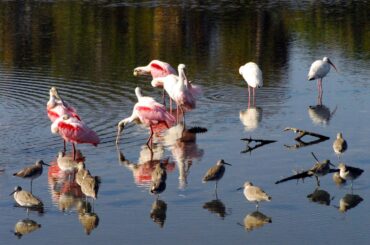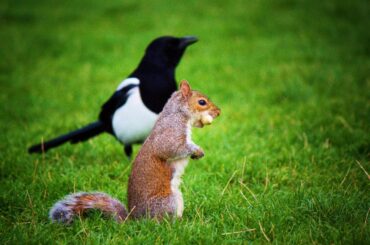Have you ever wondered why hummingbirds chase each other in the sky? This article will explain this unique habit and explore the fascinating world of these little, colorful birds.
Hummingbirds are extraordinary for their speed and glossy feathers. Only these birds can float in midair due to their quick wing flaps, which can exceed 80 times per second.
Our attention is drawn to these young aviators’ airborne chases. In gardens and parks, hummingbirds play tag quickly.
Solving this hummingbird riddle will teach us about these energetic birds. Examine why hummingbirds chase one other and what it means for these tiny bird dynamos.
Playful Courtship Displays

Hummingbirds are known for their charming and playful courtship displays, like a magical dance in the sky. These displays are essential for finding the perfect mate. But one hummingbird chases the others away.
Photograph a male and female hummingbird fluttering their wings fast, almost blurring. Aerial acrobatics, swooping in U-shaped patterns, are generally started by the male to attract the female. It’s like watching a tiny fighter jet putting on a show in the air!
Not only do hummingbirds showcase their flying skills, but they also use their voices in this intricate dance of love. They create soft, melodious chirps and buzzing sounds, almost like a secret hummingbird language. This auditory part of courtship helps them communicate their interest and attraction to each other.
When the female finds a male’s display impressive, she may respond with her flirtatious moves. This back-and-forth helps the hummingbird couple evaluate each other as potential mates.
These entertaining courtship rituals help hummingbirds select a mate to build a family and raise healthy young.
Territorial Aggression
Hummingbirds are remarkable little creatures known for their territorial nature. These pint-sized birds may be small, but they take their territories seriously. They establish these areas mainly for two crucial reasons: food and nesting sites. Hummingbirds guard their favorite food sources, like nectar-filled flowers and sugar water feeders.
They demand constant access to these vital energy sources. They also choose their nesting sites carefully, carefully selecting safe and hidden spots to protect their eggs and young ones from potential threats.
When it comes to territorial disputes, hummingbirds can be pretty aggressive. Picture this: two hummingbirds encounter each other in the same territory, and it’s like a tiny aerial showdown! They engage in aggressive behaviors like rapid dive-bombing, hovering face-offs, and even fierce chirping.
These little battles can be intense as they defend their turf. The goal is to assert dominance and drive away the intruder. Despite their cuteness, hummingbirds use these airborne tricks to get nectar and protect their eggs.
The Fine Line Between Play and Conflict

Territorial violence and courtship are different. A tiny line might make them look alike.
Imagine you’re watching a group of colorful birds in the wild. Some birds, like peacocks, engage in fancy dances and show off their vibrant feathers to impress a potential mate. This is a courtship display. It’s like they’re saying, “Look at me! I’m the best partner for you!”
Picture another scenario where two birds fiercely defend a specific area, like a tree or a nest. They might puff up their chests, spread their wings, and make loud noises to protect their territory. This is territorial aggression. They’re saying, “This is my space, and I won’t let anyone in!”
Both courtship displays and territorial aggression involve birds showing off and being assertive. The critical difference is in the intention. Courtship displays are about attracting a mate, while territorial aggression is about defending a space.
It may be challenging to determine the difference between the two at times. Nature has its unique way of making us work for what we get.
Playful Interactions vs. Actual Fights
After looking at how courtship displays and territorial violence might appear alike. Here are some contrasts. It’s like decoding the hidden language of animals!

Deciphering Hummingbird Behavior
To understand hummingbird behavior, learn how to identify courting from violence in these little, intriguing birds.
- Look for Friendly Gestures: When watching hummingbirds, watch for friendly gestures, like graceful hovering and quick dives. These actions often signify courtship as they try to impress a potential mate.
- Pay Attention to Vocal Hints: Listen closely to their tiny chirps and twittering sounds. Hummingbirds can communicate their intentions through these soft vocalizations, giving clues about their mood and preferences.
- Observe the Tail Feathers: Another key to deciphering their behavior is observing their tail feathers. Suppose you notice them fanning out and displaying vibrant colors. In that case, it’s likely a sign of courtship, as males try to catch a female’s attention.
- Beware of Aggressive Postures: They can communicate their intentions through these soft vocalizations, giving clues about their mood and preferences.
- Patience is the Key: Remember, patience is your best friend when observing hummingbirds. Their behavior can change quickly, so spend time watching them closely to pick up on subtle cues.
- Be a Keen Observer: To decipher hummingbird behavior, sharpen your observation skills. Be aware of their body language, unexpected shifts, and interactions with nearby hummingbirds.
Final Thoughts
Understanding hummingbird behavior involves recognizing their gestures, sounds, and postures. When they chase each other, it’s often a sign of either courtship or territorial disputes. Their fast, nimble motions and vivid displays make these little birds fascinating to observe and understand.
These incredible creatures remind us of the importance of conservation efforts. They are beautiful and complex, but we must maintain their ecosystems and give them safe spaces. Doing so will ensure that these beautiful birds beautify our globe for years.
FAQs
Do Hummingbirds Hitch Rides on Other Birds?
No, hummingbirds do not typically hitch rides on other birds. They are highly independent and agile flyers, capable of hovering and maneuvering independently.
Are Hummingbirds Mean?
They can be territorial and competitive when it comes to defending their food sources, but they are not inherently “mean.” Their behavior is driven by the need to secure their territory and access to nectar.
Are Hummingbirds Playing or Fighting?
Hummingbirds often engage in aerial chases and displays that may appear to be playing. Still, these behaviors are primarily related to territorial disputes and mating rituals. They are not playing like some animals; instead, they usually defend their territory or try to attract a mate.
What Do You Feed a Baby Hummingbird?
Baby hummingbirds need protein from fruit flies and a nectar combination of one part sugar to four parts water, heated and chilled.
What Does It Mean When a Hummingbird Hovers Near You?
When they hover near you, it could be curious, checking for potential food sources, or defending its territory. It doesn’t necessarily have a specific meaning, but it’s a fascinating interaction with these tiny birds.





